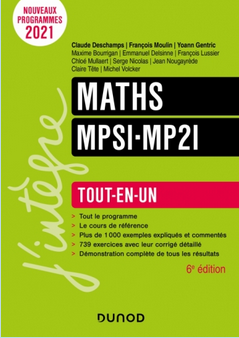Soit $r$ une racine de $(\Ec)$. Cherchons $y$ solution de $(E)$
de la forme :
\[
y : x \mapsto e^{rx}\,z(x).
\]
avec $z$ deux fois dérivable sur $I$.
Pour tout $x\in \R$, on a alors :
\begin{align*}
y(x) &= \phantom{r^{2}}z(x)\,e^{rx} \\\\
y'(x) &= r\phantom{^{2}}\,z(x)\,e^{rx} + \phantom{2\,r \,}z'(x) \,e^{rx} \\\\
y''(x)&= r^2\,z(x)\,e^{rx} + 2\,r \,z'(x) \,e^{rx} + z''(x)\,e^{rx}
\end{align*}
et donc :
Comme $r$ est solution de $(\Ec)$, dans la combinaison linéaire :
\[
y''(x) + a\,y'(x) + b\,y(x),
\]
les termes en $z(x)$ disparaissent car leur coefficient est :
\[
r^{2} +a\,r+b = 0.
\]
\begin{align*}
y''(x) + a\,y'(x) + b\,y(x)
= \bigl((a+2\,r)\,z'(x) + z''(x)\bigr) \,e^{rx}.
\end{align*}
Par suite, $y$ est solution de $(E)$ dès que :
\[
\fa{x\in \R} (a+2\,r)\,z'(x) + z''(x) = c(x)\,e^{-r x}.\tag{$E'$}
\]
D'après l'étude des équations différentielles linéaires d'ordre $1$,
l'équation :
\[
u'+(a+2\,r)\,u=c(x)\,e^{-r x}
\]
possède (au moins) une solution $u$, dérivable
et donc continue sur $I$ ;
on est alors sûr qu'il existe une primitive $U$ sur $I$
Comme $U$ est alors solution de $(E')$, la fonction :
$$ x \mapsto U(x) e^{rx}$$
est alors une solution de l'équation $(E)$,
ce qui prouve l'existence d'une solution.
Remarque La méthode précédente (déjà vue pour les équations du premier ordre
C'est la méthode de variation de la constante.
)
vient de permettre de ramener la solution d'une équation différentielle
linéaire du second ordre à celle d'une équation différentielle
linéaire du premier ordre. On pourrait l'utiliser avec le même bénéfice
même si les coefficients $a$ et $b$ ne sont pas constants.
